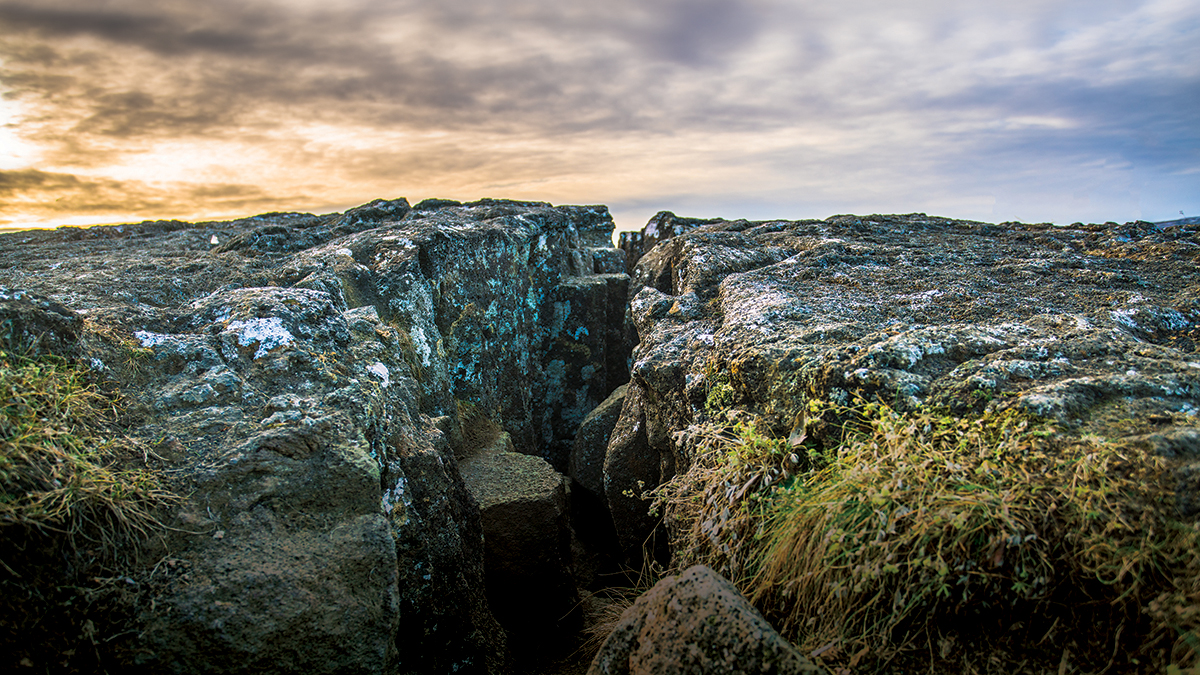feature
They Really Used to Think That?
Evaluating current and historical claims in geology using adapted primary scientific literature
The history of science is replete with examples of claims that were once accepted and are now discarded (Oreskes 1988). Helping students understand that the scientific community’s claims change through time, sometimes radically, allows them to develop a well-grounded sense of the nature of science. Learning to reason about how scientific claims come to be accepted, and later refuted, is important for understanding the tentative nature of scientific claims (Allchin 2012). The unit described here scaffolds students’ understanding of plate tectonics and the nature, and history, of geological sciences by engaging them in the process of evaluating competing scientific claims.
Evaluating the connection between claims and evidence is central to science (Erduran, Simon, and Osborne 2004). Rather than evaluating a claim in isolation, scientists often weigh the evidence for two or more competing claims. Practicing scientists accept some claims and rule out others; their ability to evaluate the quality of evidence is critical for deciding which claim is more accurate when there are competing claims to consider. In this unit students evaluate evidence quality, learn central organizing principles of geology, and develop a more sophisticated understanding of the nature of science in the context of a model-based inquiry unit. Pedagogical techniques include: Making use of historical cases where scientists contended with competing claims Promoting disciplinary literacy with adapted primary literature Using graphical organizers to scaffold student reasoning
This unit helps students evaluate evidence of crustal movements as they relate to the theory of plate tectonics (HS-ESS1-5) and uses modeling to develop a mechanistic account of thermal convection’s role in plate tectonics (HS-ESS2-3). The unit begins with a pre-modeling phase of several formative assessments, followed by three cycles of scientific reasoning. Each cycle involves evaluating four pieces of evidence, relating them to competing models, and generating an evidence-based argument about which model is better supported by the evidence (Figure 1).
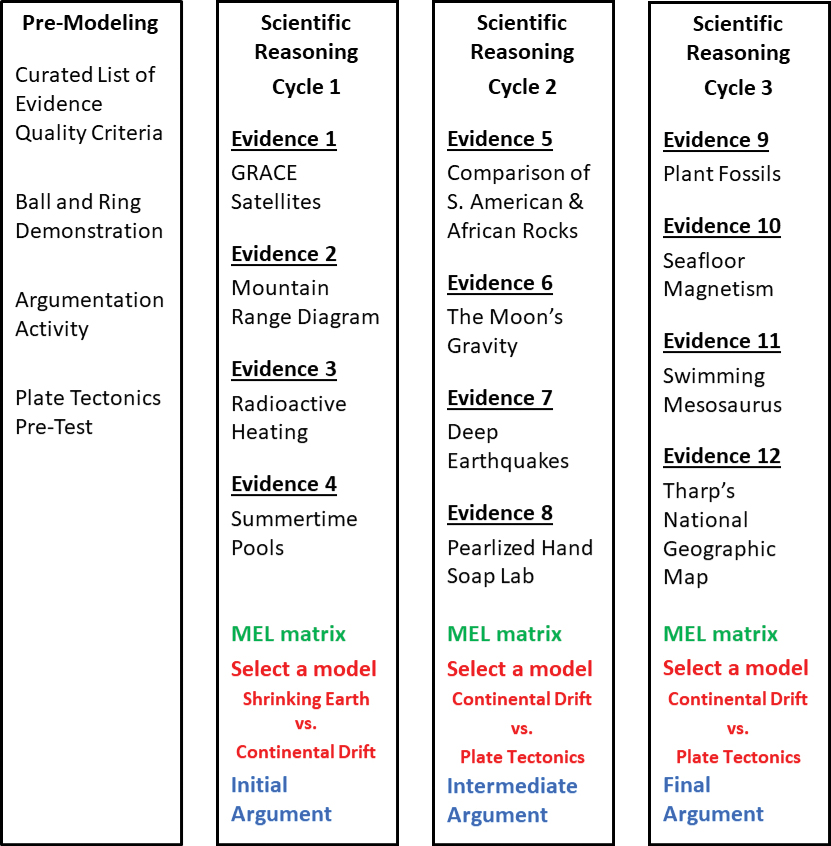
Reasoning with adapted primary literature instructional sequences.
The entire unit takes about two weeks (ten class periods of 45–50 minutes) to complete. We have developed partnerships across two school districts, one rural and one diverse urban district. The unit is designed for high-school level students; our discussion here focuses on its implementation with 9th grade physical science students by multiple teachers.
Three models of Earth processes
When describing Science and Engineering Practice 7, engaging in argument from evidence, the Framework for K-12 Science Education states that “Exploration of historical episodes in science can provide opportunities for students to identify the ideas, evidence, and arguments of professional scientists” (National Research Council 2012, p. 74). Engaging with authentic episodes from the history of science allows students to learn how claims are accepted and rejected over time in the scientific community. In this unit students learn about three models describing how the Earth’s surface might experience large-scale changes over long periods of time: The shrinking Earth model Continental drift Plate tectonics
These three geologic models have been accepted by different factions of the scientific community at different times (Oreskes 1988).
The models considered in this unit come from the late 1800s through the mid-1900s. Geology in that era was not diverse or inclusive, and was not focused on promoting equity. Highlighting this for students is important so they understand that many scientists, and the institutions they worked in, were explicitly discriminatory. For example, geologist Marie Tharp, whose work is included in Evidence 12, was not allowed to go into the field to collect data, wasn’t paid as well as her male colleagues, and was only admitted into graduate school to pursue a master’s degree in geology because of low male enrollment during World War II.
Tharp’s story is important but unfortunately not unique. Into the 1960s women were discouraged, if not outright barred, from taking positions in academia (Burek and Kölbl-Ebert 2007). The gender gap in geosciences has closed significantly; however, racial and ethnic diversity in the geosciences remains low in the United States (Bernard and Cooperdock 2018).
One major theme of this unit is to highlight what makes scientific evidence reliable, or not, because the reliability of evidence is a significant factor in the evaluation of competing scientific claims. Having students learn about the personal stories of geologists is one way for them to understand how evidence is collected, analyzed, and processed in a historical and social context.
Another way to enrich this unit is to discuss how a lack of diversity and equity shaped whose voices were included and whose were historically excluded from geology. Teachers can facilitate discussions to enrich students’ understanding of the nature of science by illustrating historical and current challenges underrepresented groups have faced, and how progress on diversity can improve scientific practice. For example, wildlife biologist Flo Gardipee’s “…First Nations perspective (she is Cherokee and Irish) led her to seek non-invasive methods for sampling buffalo DNA” (Medin and Lee 2012). Improvements to scientific practice include more reliable methods, such as evaluating the quality of evidence and how evidence relates to models. The resources at the end of the article provide additional content for teachers to incorporate into class discussion.
Student-led investigations into case studies of scientists can be a powerful way for students to generate their own understanding of scientific discovery by learning about the lives, challenges, and accomplishments of scientists past and present. Table 1 provides a sample of underrepresented minority and women geologists which can be used as a starting point for students to begin their investigations into these cases. This is just a sample of the many geologists and earth scientists whose work has contributed to science; teachers are encouraged to adapt this as they see fit and have students explore the lives of other scientists as well.
| Table 1. Notable underrepresented minority and women geologists. | ||||||||||||||||||||||||
|---|---|---|---|---|---|---|---|---|---|---|---|---|---|---|---|---|---|---|---|---|---|---|---|---|
|
The role of evidence
Students use 12 pieces of evidence to support and refute competing scientific claims from three geologic models, leading them to a nuanced understanding of how plate tectonics came to be the dominant theoretical lens. The unit challenges students to think not only about resolving conflicting scientific claims, but also to consider the essential role that evidence, particularly the quality and diagnosticity of evidence, plays in scientific thinking.
The Framework for K-12 Science Education positions engaging in argument from evidence as an opportunity to show students how “…ideas that survive critical examination even in the light of new data attain consensual acceptance in the community, and by this process of discourse and argument science maintains its objectivity and progress” (National Research Council 2012, p.71). During the unit students engage in this process as a community of inquirers focused on evaluating authentic scientific evidence to winnow down a field of competing claims.
Promoting disciplinary literacy
This unit makes use of a pedagogical technique called Adapted Primary Literature (APL) to introduce students to authentic scientific evidence that has been distilled and made comprehensible for secondary science students (Yarden 2009). APL makes use of “the original research articles […] adapted to match students’ knowledge, reading ability and cognitive skills, while retaining the authentic characteristics of the original articles and taking into account the practical reasoning involved in producing scientific knowledge” (Ariely and Yarden 2018, p. 208).
APL was chosen for three reasons: Developing disciplinary literacy is a major aim of the Next Generation Science Standards (NGSS Lead States 2013). It maintains the original argumentative style of writing (claims, evidence, and reasoning) that is often lacking in textbooks. It provides an opportunity for students to reason about competing claims with multiple pieces of authentic scientific evidence at a level that is developmentally appropriate.
An example of an APL article is shown in Figure 2. Further support for this approach comes from the Framework for K-12 Science Education (National Research Council 2012) which states that “…reading, interpreting, and producing text are fundamental practices of science in particular, and they constitute at least half of engineers’ and scientists’ total working time” (National Research Council 2012, p. 74). Extracting information from discipline-specific texts and using it to make informed judgments about claims is one of the primary jobs of a practicing scientist, and is an important skill supported by current science standards (NGSS Lead States 2013).
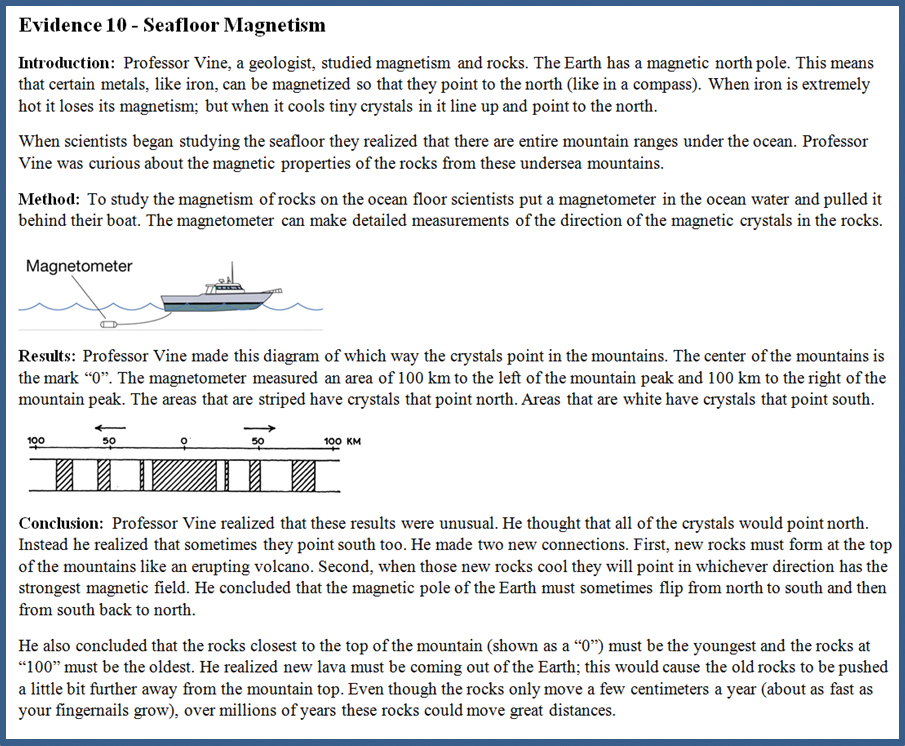
Example adapted primary literature evidence.
The APL approach involves a significant amount of reading, writing, and listening, therefore it is important to meet the needs of diverse learners, particularly ELL students, who may require some differentiation. Suggested techniques include: Giving students the evidence a day or two before they discuss it in class so they have additional time to engage in sense-making of the text and meaning-making with respect to the science content Offering students multiple modalities to represent their learning, like drawing annotated models
The MEL matrix discussed in the next section provides additional support for differentiation. Students circle words representing relational reasoning connecting evidence and models, and numbers representing their evaluation of evidence quality, thus demonstrating higher-order thinking with minimal language demands.
Graphical organizer
We organized instruction using an updated and modified Model-Evidence Link (MEL) matrix (Rinehart, Duncan, Chinn, Atkins, and DiBenedetti 2016; Suthers and Hundhausen 2003). This graphical organizer (Figure 3) is a generalizable scaffold for helping students systematically coordinate claims and evidence. Students are able to visualize how each piece of evidence supports or refutes each claim. A useful feature of this organizer is that the claims (at the top) and the evidence (along the side) can be filled in with any science topic that makes use of evidence-based argumentation. While this unit focuses on earth science, the MEL matrix can be used in any discipline.
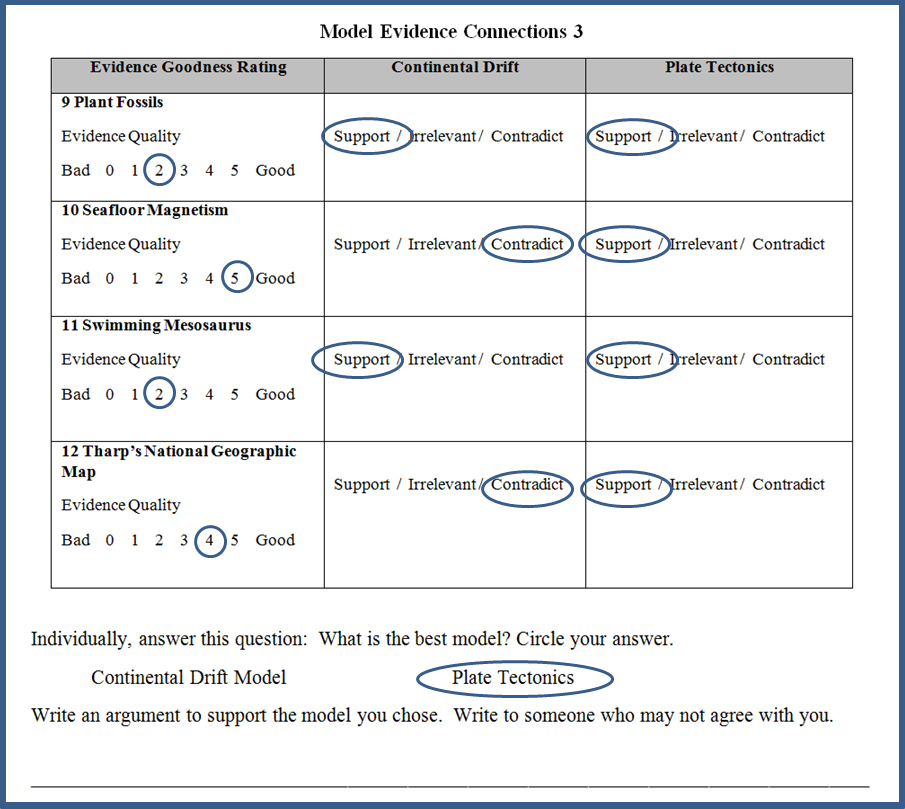
Model evidence link (MEL) matrix.
Unit overview
The unit has four phases: Pre-Modeling Phase (1 class period) Scientific Reasoning Cycle 1 (3 class periods): the shrinking Earth model vs. continental drift Scientific Reasoning Cycle 2 (3 class periods): continental drift vs. plate tectonics Scientific Reasoning Cycle 3 (3 class periods): a resolution of continental drift vs. plate tectonics
Each scientific reasoning cycle follows a pattern described in Figure 4: students evaluate and discuss four pieces of evidence, complete a MEL matrix, select a model, and write an evidence-based argument.
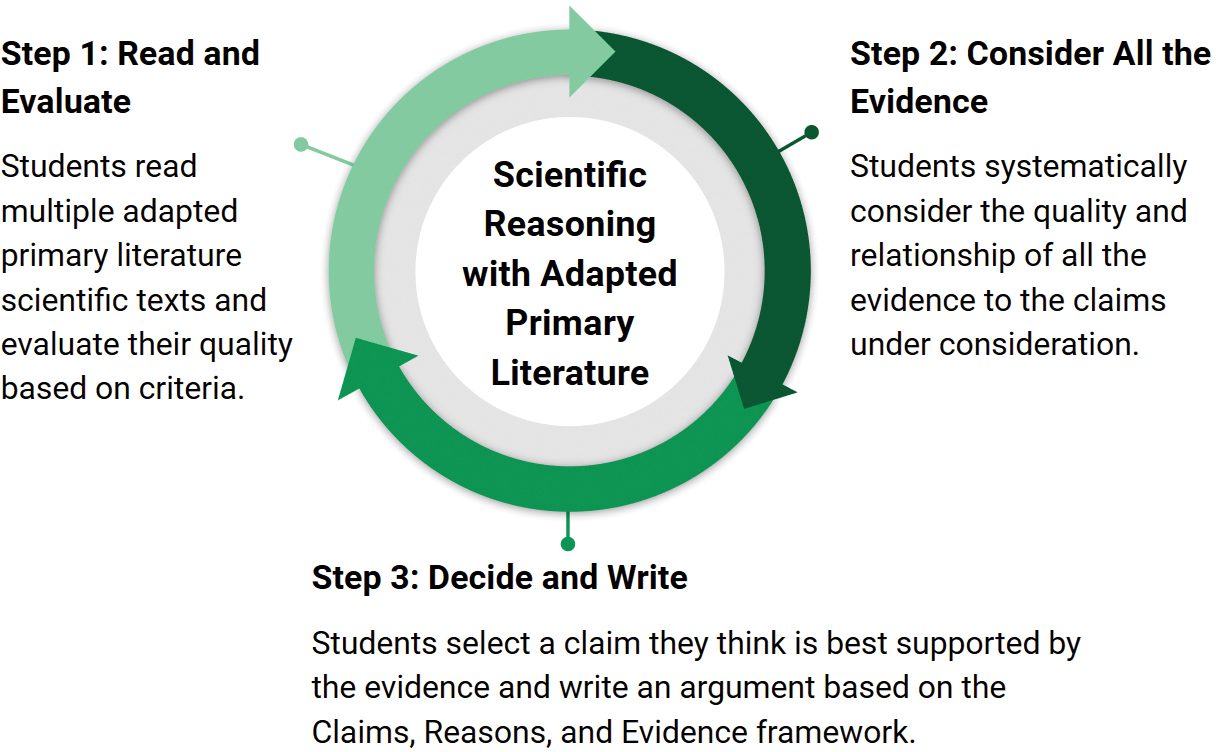
Adapted primary literature cycle.
Pre-modeling phase
The unit begins with several formative assessments. The first solicits students’ ideas about what counts as scientific evidence, what it is used for, and what constitutes good evidence versus bad evidence. After a brief period of individual work, students discuss their ideas with their groups (3-4 students) and then as a class. The teacher leads a discussion during which students share their ideas, resulting in a curated class criteria list for what counts as good evidence and bad evidence. Figure 5 is one student’s record of the class list. Students use this shared set of criteria to evaluate the evidence they encounter throughout the unit.
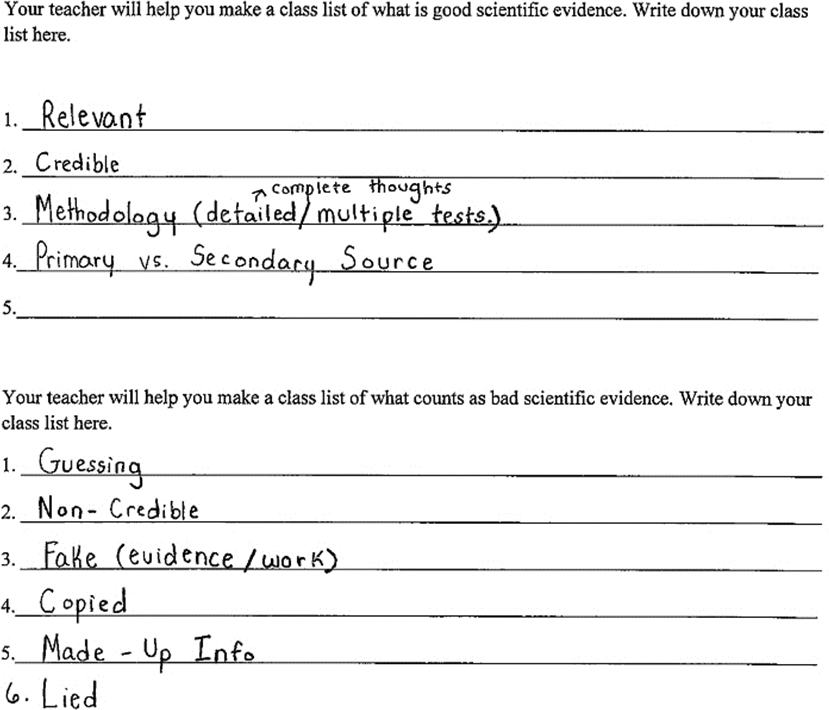
Evidence quality class list.
Next, teachers use the classic ball-and-ring demonstration to illustrate that objects expand as they are heated. Students then read several short arguments and evaluate (with a very simple rubric) the quality of those arguments, as a formative assessment for argumentation. Finally, students take a geologic content pre-test where they are asked the following: “The Earth’s surface contains both continents and oceans. Do the continents and oceans change shape, size and/or location over time? Explain your reasoning.” Students draw a model of how they think the Earth’s surface changes (or doesn’t) and then explain their thinking.
The pre-test revealed a wide range of conceptions. Figure 6 shows one student’s answer to the geologic content pre-test with a pattern of fragmented knowledge. They knew that plates exist and move but they had a misconception that the Earth is expanding and contracting as though pulsating. Most important to note is that they didn’t cite any mechanism by which the continents move, just that they do.
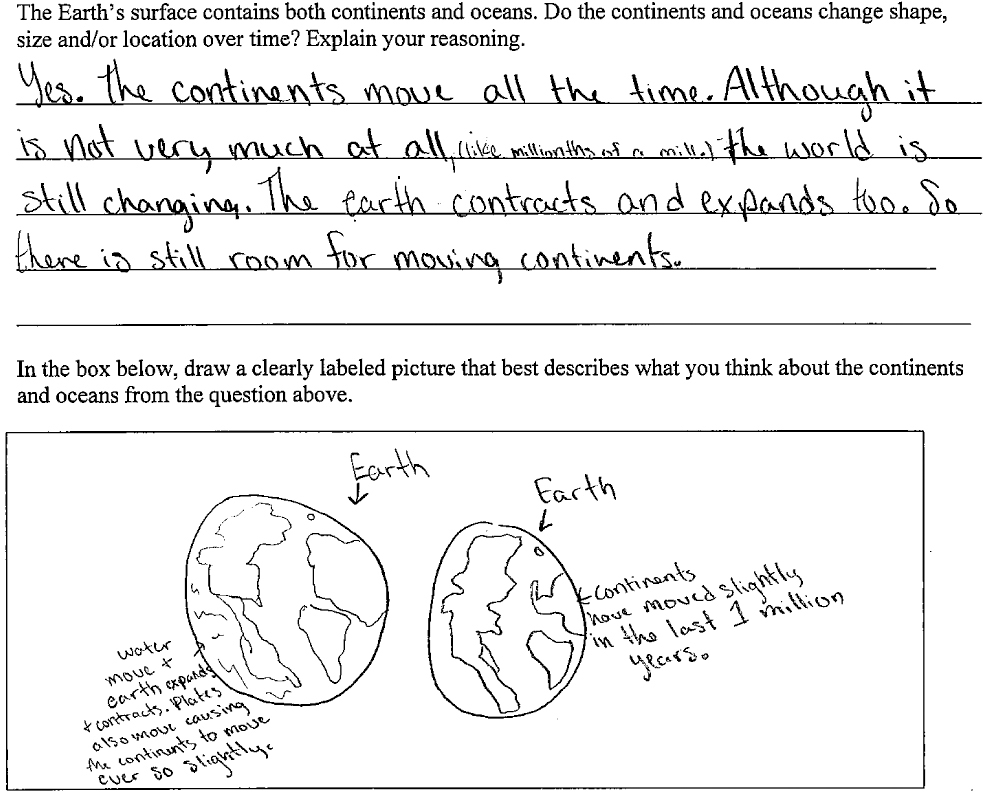
Student formative geology assessment.
Scientific reasoning cycle 1: scientific arguments and modeling
This unit was our students’ first encounter with modeling and argumentation. Students attempted to resolve a historical geoscience dilemma—which model is better at explaining features on the Earth’s surface: the shrinking Earth model, or continental drift. We introduced students to both models (see Online Connections) and they used several pieces of APL evidence to rule out the shrinking Earth model and show that, given the evidence they had, continental drift is the better model. A summary of the evidence for all three reasoning cycles is shown in Figure 7. To scaffold student reasoning, we asked one of four kinds of questions after each piece of evidence (Figure 8). Students discussed the evidence in pairs, completed a MEL matrix, wrote a scientific argument, and held a class discussion about their arguments. Students received formative feedback from their teachers about their argument quality based on a rubric and teacher comments.
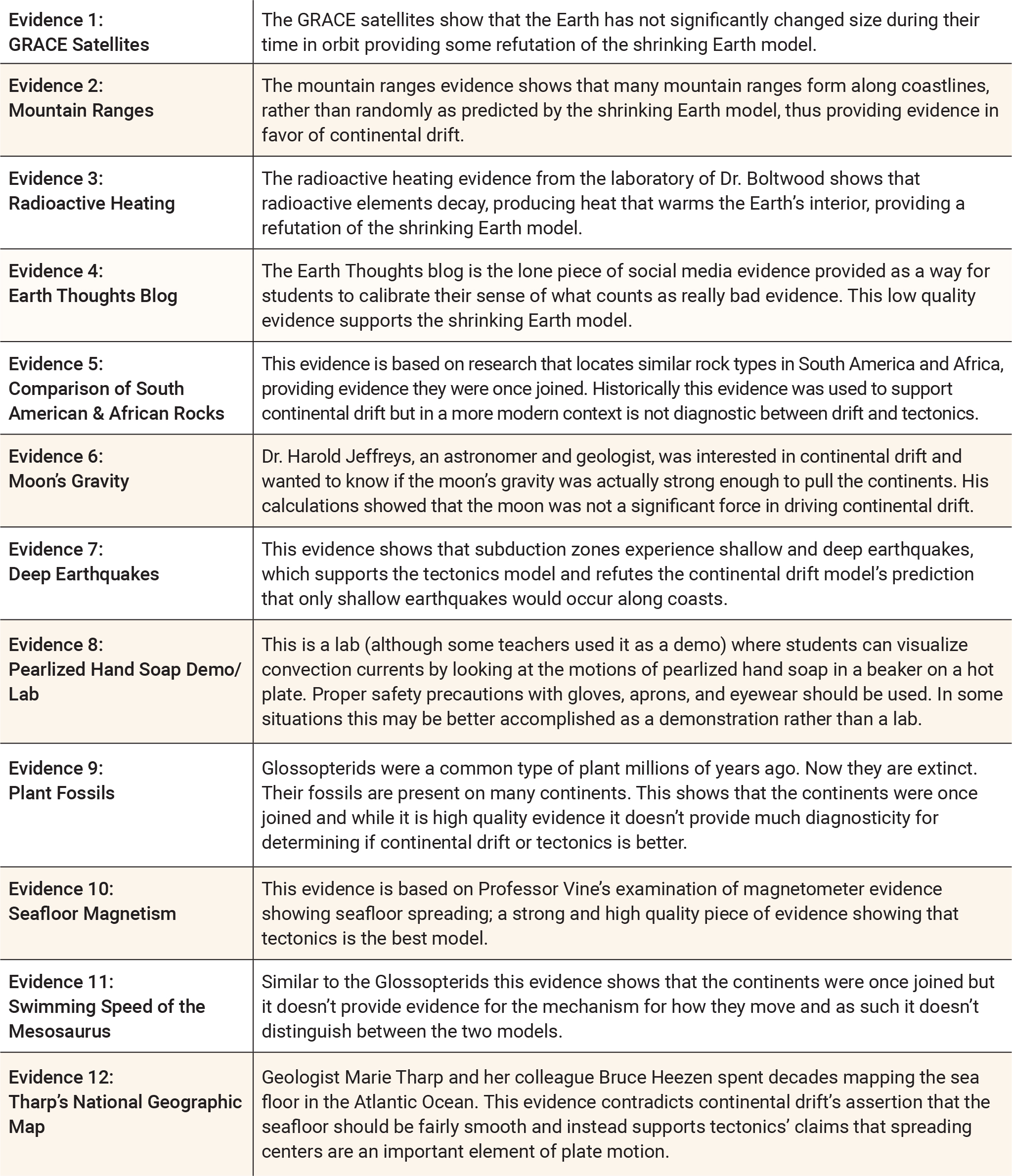
Evidence summary sheet.
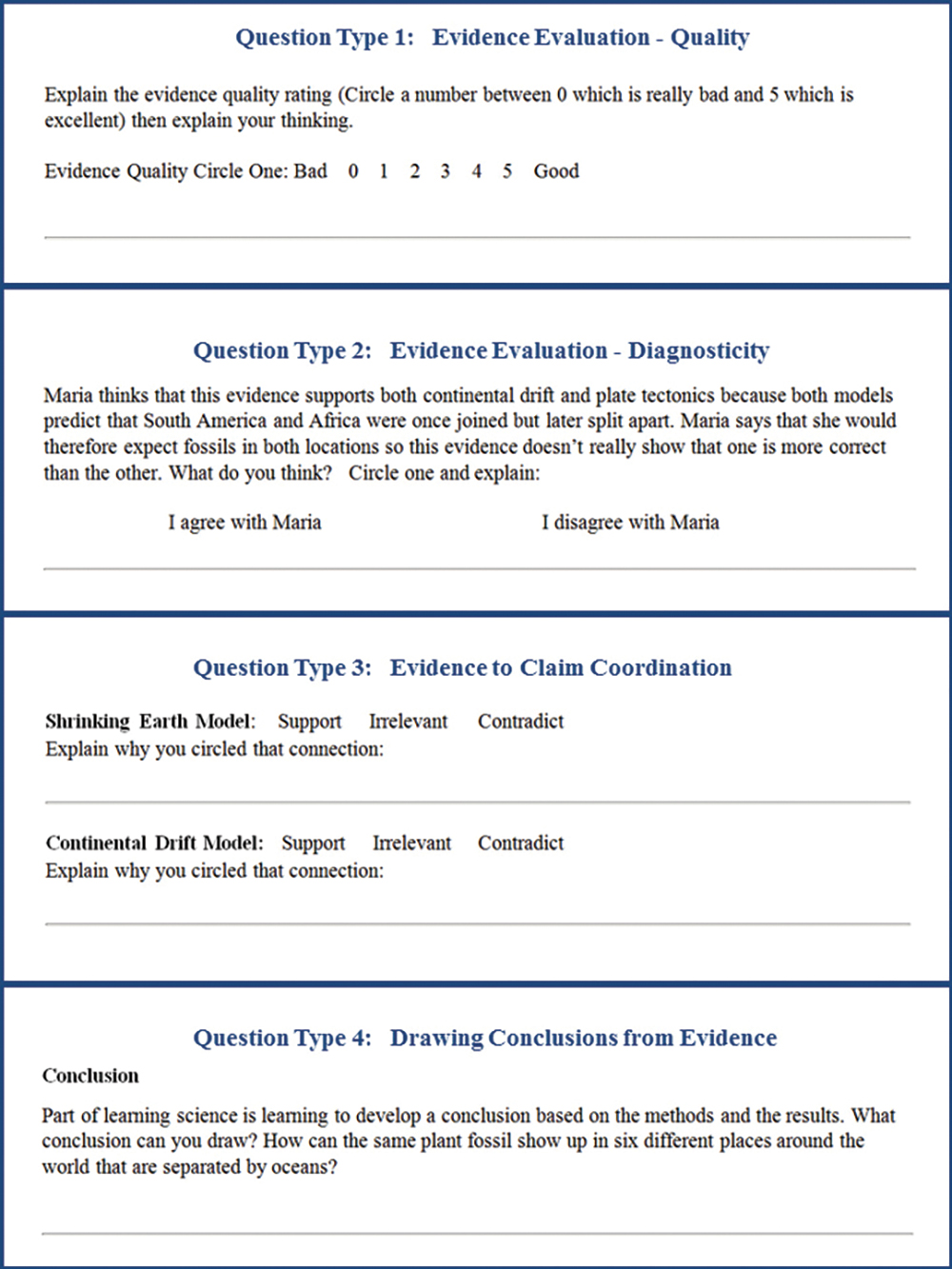
Evidence question types.
Instructional guidance for cycle 1
Since this was the students’ first time working with models, evidence, and arguments, this cycle focused on developing the epistemic norms of the classroom by focusing students’ thinking and talk around the end-of-evidence questions (Figure 8). Using variations on these questions not just in Cycle 1 but throughout the entire unit gave students practice in thinking productively and afforded teachers opportunities to have students discuss their answers in groups as well as share out periodically with the class.
Teachers felt that the end-of-evidence questions were a very important element for engaging students in thinking more deeply about the evidence itself and the evidence to model connections. Teachers said rotating between question types after each piece of evidence was vital to students thinking about the entire modeling process (evaluating claims, evaluating evidence, generating arguments, etc.) One teacher, when referring to Question Type 2 in Figure 8, said that “The scenario questions really make them think about what a [simulated] peer says so it is like an individual peer review of their thinking process. They still have to evaluate and figure out why they agree or disagree so it gets them to be mentally prepared before they discuss it.”
These questions also drew students’ attention to making sure they coordinated the evidence with pertinent claims. Figure 9 shows one student’s answer to an “evidence to claim” coordination question where the student has correctly identified Evidence 2 as being highly diagnostic between the two models.
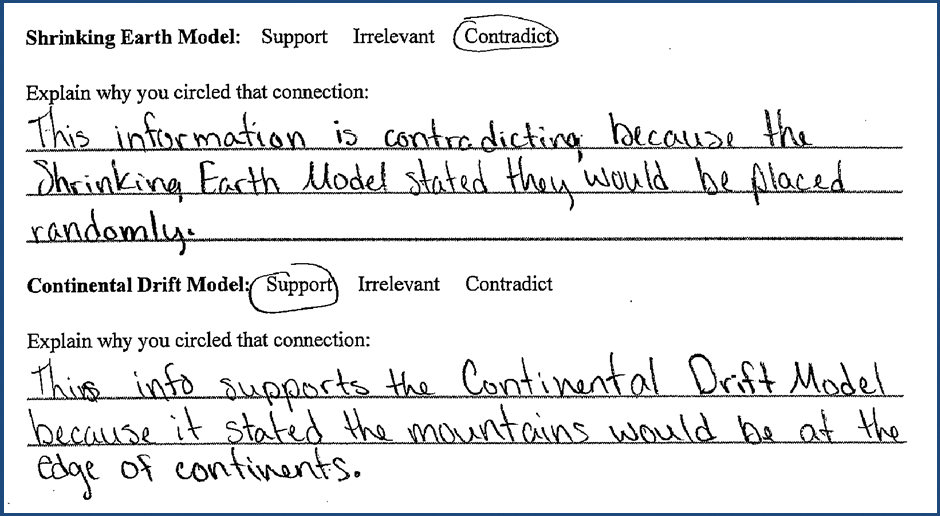
Student answers to Evidence 2 questions.
Scientific reasoning cycle 2: predictions and mechanisms
In Cycle 2, we present students with a significant conceptual challenge: learning to use evidence to refute a model that they once accepted. In the history of science this has been a significant impediment to the advancement of knowledge. Cognitive processes like confirmation bias (Kunda 1990) drive students and scientists alike to attempt to conserve past ideas by devaluing legitimate evidence. We introduced students to the plate tectonics model and they received four pieces of new evidence.
Differentiating between continental drift and plate tectonics invokes deep connections to the mechanisms and predictions made by both models. To scaffold student understanding, the evidence emphasizes the differences in mechanisms between the two models. While many mechanisms were once proposed for continental drift, we focused on the Moon’s gravity, which received some attention from the scientific community at the time. Some evidence might seem to support both models (like Evidence 5 which simply shows that South America and Africa were once linked) while other evidence, like Evidence 6, strongly rules out the possibility of drift being the correct explanation. Ruling out a model, however, does not necessarily show that the alternative is better, and the third reasoning cycle helps students engage with this important insight into the nature of science.
Instructional guidance for cycle 2
A key aim of Cycle 2 is to focus student attention on the mechanisms and predictions made by each model, building on the modeling and argumentation competencies in Cycle 1. For example, if a model makes a prediction, there should be evidence that this prediction is true. For class discussions it is productive to draw students’ attention to predictions made by each model and ask students to evaluate that prediction in light of the evidence. Similarly, each model should have a mechanism (i.e., a causal sequence) supported by evidence that describes changes over time (e.g., in this context how tectonic plates move).
Scientific reasoning cycle 3: diagnosticity of evidence
In this final cycle students see stronger evidence that plate tectonics is the best model for how the continents move. While historically-authentic pieces of evidence like the plant fossils present on multiple continents (Figure 7, Evidence 9) and the mesosaur (Evidence 11) are useful in determining that the continents were once joined, they are not as helpful for ascertaining the mechanism that has driven them apart. This provides a leverage point for significant development in students’ understanding of the nature of science; that evidence, even good evidence, may be non-diagnostic (it doesn’t show that one model is more correct).
Teachers took this opportunity to move students toward diagnostic evidence concerned with mechanisms and predictions. For example, seafloor spreading (Evidence 10) is strongly concerned with mechanisms related to plate tectonics and is highly diagnostic in showing that tectonics is superior to drift. Further, Evidence 12 concerns one of drift’s principal predictions, that seafloors would have to be flat enough for continents to move through. The discovery of mid-ocean ridges showed that the seafloor is far from flat, thus contradicting a central prediction of drift, but supporting tectonics. Students finish the third cycle by again completing a MEL matrix and writing an evidence-based argument.
Instructional guidance for cycle 3
The argumentation rubric mentioned earlier (Figure 10) is designed to promote arguments that are structurally more sophisticated by attending to not just the model that students support, but also why the alternative claim is not the best, thereby reducing the tendency to engage in confirmation bias. Further, the rubric assesses the depth of students’ cognitive processing by addressing how they describe the evidence, as well as their relational reasoning for connecting evidence to models. One alternative assessment technique would ask students to draw and annotate a model and briefly explain how it is connected to the evidence.
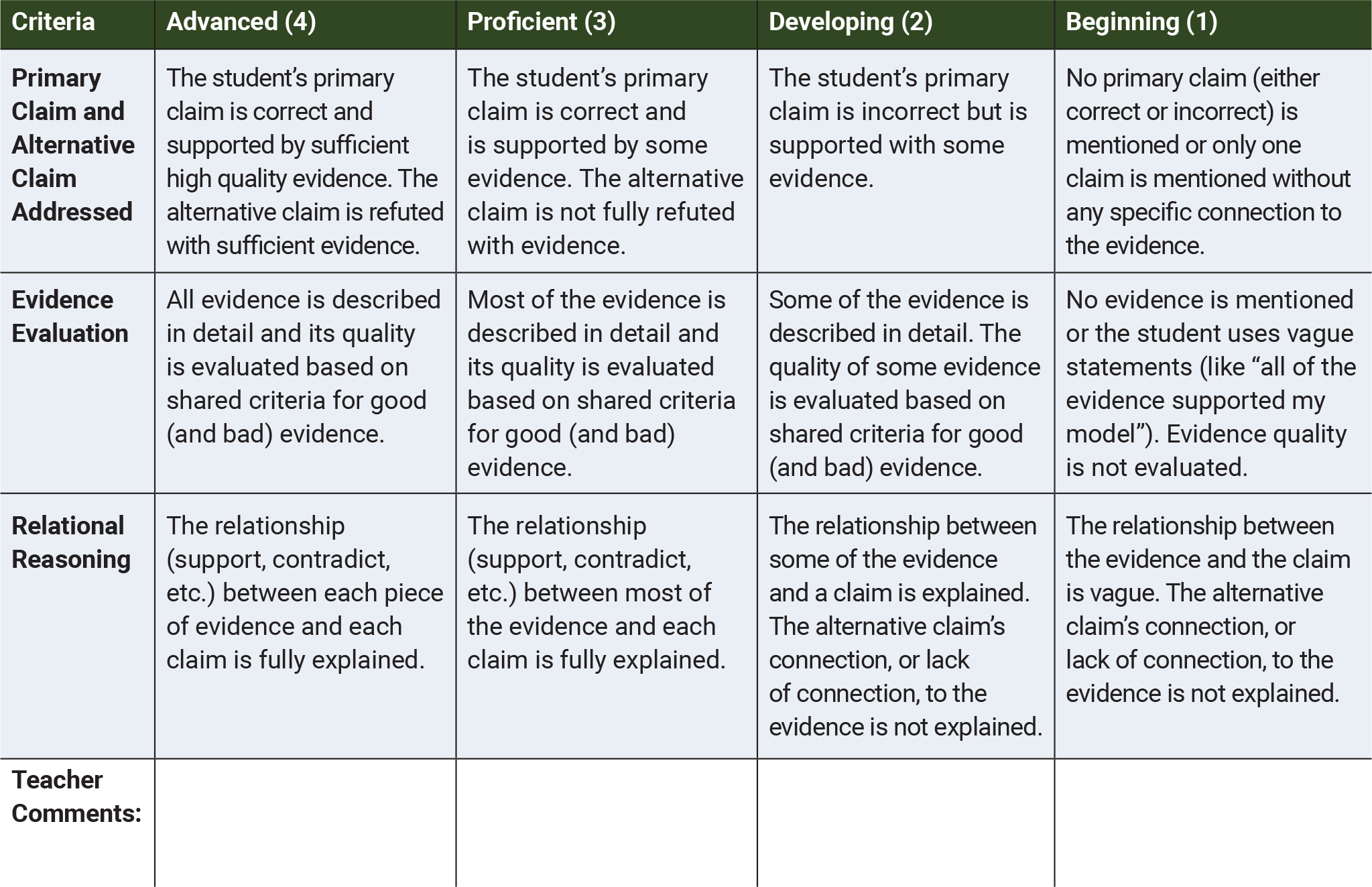
Rubric for written arguments dealing with competing claims.
Concluding thoughts: deepening students’ understanding of the nature of science
The goals of this unit are to help students learn central organizing principles of geology, and also to develop a more sophisticated sense of the nature of science. While it is important for students to learn to evaluate claims, they should be encouraged to dig even deeper and not just use evidence to support or refute a claim but also to evaluate the properties of the evidence itself. Further, students learn that the consensus on scientific models changes over time as additional evidence accumulates, particularly evidence that is greater in diagnosticity. Finally, focusing on the predictions and mechanisms present in a model provides opportunities to engage in deeper levels of argumentation beyond just claims, reasons, and evidence.
Ronald Rinehart (ron.rinehart@uni.edu) is an Assistant Professor in the Department of Educational Psychology, Foundations, and Leadership Studies at the University of Northern Iowa, Cedar Falls, Iowa.
Earth & Space Science Pedagogy High School



